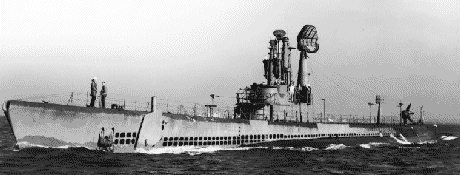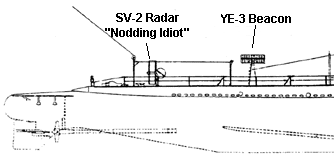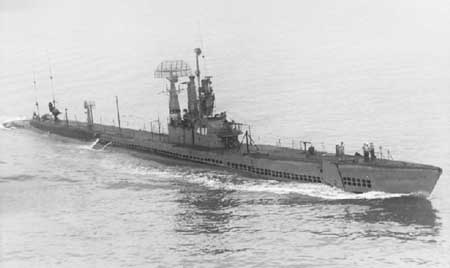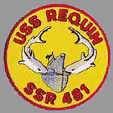|
Before REQUIN's story
continues, a brief background must be given on the radar picket program.
Born out of experiences during the latter stages of World War II, the
Navy began to consider placing early warning radar equipment aboard submarines.
This idea resulted from the severe losses the Navy experienced during
the invasion of Okinawa, where surface picket ships bore the brunt of
the kamikaze assault. Faced with an abundance of new and relatively new
submarines, the Navy experimented with hastily-converted surface ship
radar equipment aboard submarines. REQUIN, after nearly a year in commission,
and SPINAX (SS 489), while still on the ways at Portsmouth, became the
first radar picket submarines in the US Navy. Envisioned to carry radar
capable of controlling friendly aircraft defending against attacking enemy
aircraft, directing outbound aircraft, it was envisioned that these radar
picket submarines could also provide an early warning capability to the
surface fleet.
 Faced
with problems that would last throughout the life of the radar picket
program, REQUIN would encounter overcrowding problems (she retained all ten torpedo tubes until her MIGRAINE conversion) and flooding
(the radar mounted on her stern would short out Faced
with problems that would last throughout the life of the radar picket
program, REQUIN would encounter overcrowding problems (she retained all ten torpedo tubes until her MIGRAINE conversion) and flooding
(the radar mounted on her stern would short out
quite frequently), REQUIN was subjected to another more extensive conversion
as a radar picket under the somewhat appropriately named MIGRAINE Program. Designated
as SSR-481in January of 1948, REQUIN would lose her four stern torpedo
tubes, with the space gained in the forward part of the stern room being
converted into a full-blown air control center (REQUIN vets who served
aboard during the radar picket days would refer to this as the combat
information center). The remaining space, where the tubes themselves once
were, was converted into berthing space for the extra crew. In addition,
REQUIN lost the use of the two bottom tubes in the forward torpedo room,
which were converted into storage lockers. Topside, the 40 mm cannon on
the aft cigarette deck was removed, with the space being taken up by an
SR-2 air search radar. In addition, REQUIN received a YE-3 fighter controller
beacon, located above the after engine room on deck, as well as an SV-2
low angle surface search radar. (This radar, because it was located so
close to the water line near the screws, often shorted out and was commonly referred to as the "Nodding Idiot".) Finally, REQUIN
also received a snorkel, which allowed her to run her four Fairbanks-Morse
engines while submerged at periscope depth.
Tactics used by radar
picket submarines varied, depending upon the situation. Often, two radar
picket submarines would operate together and somewhat near each other.
If a submarine controlling a raid had to dive to escape enemy aircraft,
the other nearby picket would pick up the coverage until the original
controlling sub could reposition itself and resume coverage. Radar picket
submarines would often be stationed on the suspected threat axis of a
raid against friendly surface ships, often at ranges of 10,000 yards or
so. These boats would then control the intercept of attacking enemy aircraft,
control outgoing intercepting aircraft or outgoing friendly attacking
aircraft, or serve as early warning (picket) ships for the fleet.
In addition to REQUIN,
SPINAX also became a MIGRAINE II radar picket. Eight other boats were
converted to radar pickets under the MIGRAINE program: TIGRONE (SSR-419)
and BURRFISH (SSR-312) received MIGRAINE I conversions, along with six
thin-skinned Gato-class boats - POMPON (SS-267), RASHER (SS-269), RATON
(SS-270), RAY (SS-271), REDFIN (SS-272), and ROCK (SS-274) - which received
MIGRAINE III conversions.
|
|
This
engineering drawing shows the planned equipment layout in the air
control center. (Courtesy of the National Archives) |
This
drawing shows REQUIN's MIGRAINE II conning tower from the side.
(Courtesy of the National Archives)
|

This drawing
shows REQUIN's stern, with the YE-3 fighter controller beacon
(right) and the infamous SV-2 "Nodding Idiot". (Courtesy
of the National Archives)
|
Life
as a Radar Picket Submarine
 Life
for REQUIN as a radar picket was tough duty. Many of the normal fleet
boats still in service stayed out for two to three months. REQUIN, because
of her unique status as a radar picket (click on the link Life
as a Picket to see photos of life at sea aboard REQUIN), would
often stay out much longer, just coming into port to refuel and reprovision.
Sometimes, REQUIN's skippers would be creative in keeping up the crew's
morale. One skipper, Capt. David H. Green, devised a way of having steak
barbecues while REQUIN was on the surface. Using a secret marinade recipe,
he would have the grill, a 55 gallon drum cut in half and fitted with
detachable legs, brought up on deck, steaks broken out of the ship's freezer
and cooked on the grill. Life
for REQUIN as a radar picket was tough duty. Many of the normal fleet
boats still in service stayed out for two to three months. REQUIN, because
of her unique status as a radar picket (click on the link Life
as a Picket to see photos of life at sea aboard REQUIN), would
often stay out much longer, just coming into port to refuel and reprovision.
Sometimes, REQUIN's skippers would be creative in keeping up the crew's
morale. One skipper, Capt. David H. Green, devised a way of having steak
barbecues while REQUIN was on the surface. Using a secret marinade recipe,
he would have the grill, a 55 gallon drum cut in half and fitted with
detachable legs, brought up on deck, steaks broken out of the ship's freezer
and cooked on the grill.
 Along
with the boring times, picket duty did have its share of excitement. When
the radar equipment worked, which was about half the time (the SV-2 radar,
aka the "Nodding Idiot", was quite susceptible to flooding and shorting
out, due to its location near the waterline on REQUIN's stern), it often
worked well. During one picket mission, REQUIN's radar watched picked
up a fast moving surface contact. They reported the contact as being on
a heading of 090 and moving at 45 knots. The captain, thinking the men
weren't seeing things right, ordered the watch to recheck and test the
radar displays and antennas, thinking the contact's speed somewhat excessive.
When the contact again was reported at the same speed and bearing, the
radarman on duty went to the bridge, reported that everything checked
out and nothing was malfunctioning. When asked if he had been drinking
alcohol, the radarman replied in the negative. As a result, a radio message
was finally sent to the contact. The contact later turned out to be the
new passenger liner SS UNITED STATES, which had just gone into service
and was conducting speed runs during her maiden voyage. As the radar picket
program was winding down, brought upon by the advent of miniaturized transistors,
smaller radar systems which were capable of being fitted with aircraft,
so on, REQUIN continued to serve as a picket until the end of the 1950s.
In 1956, REQUIN achieved an "Outstanding" rating during an Operational
Readiness Inspection, the first and possibly only, radar picket submarine
to do so. Finally, with the advent of airborne early warning aircraft,
such as the P2V Neptune and E-2 Hawkeye, the Navy decided to end the radar
picket program in the late 1950s. Along
with the boring times, picket duty did have its share of excitement. When
the radar equipment worked, which was about half the time (the SV-2 radar,
aka the "Nodding Idiot", was quite susceptible to flooding and shorting
out, due to its location near the waterline on REQUIN's stern), it often
worked well. During one picket mission, REQUIN's radar watched picked
up a fast moving surface contact. They reported the contact as being on
a heading of 090 and moving at 45 knots. The captain, thinking the men
weren't seeing things right, ordered the watch to recheck and test the
radar displays and antennas, thinking the contact's speed somewhat excessive.
When the contact again was reported at the same speed and bearing, the
radarman on duty went to the bridge, reported that everything checked
out and nothing was malfunctioning. When asked if he had been drinking
alcohol, the radarman replied in the negative. As a result, a radio message
was finally sent to the contact. The contact later turned out to be the
new passenger liner SS UNITED STATES, which had just gone into service
and was conducting speed runs during her maiden voyage. As the radar picket
program was winding down, brought upon by the advent of miniaturized transistors,
smaller radar systems which were capable of being fitted with aircraft,
so on, REQUIN continued to serve as a picket until the end of the 1950s.
In 1956, REQUIN achieved an "Outstanding" rating during an Operational
Readiness Inspection, the first and possibly only, radar picket submarine
to do so. Finally, with the advent of airborne early warning aircraft,
such as the P2V Neptune and E-2 Hawkeye, the Navy decided to end the radar
picket program in the late 1950s.
|





